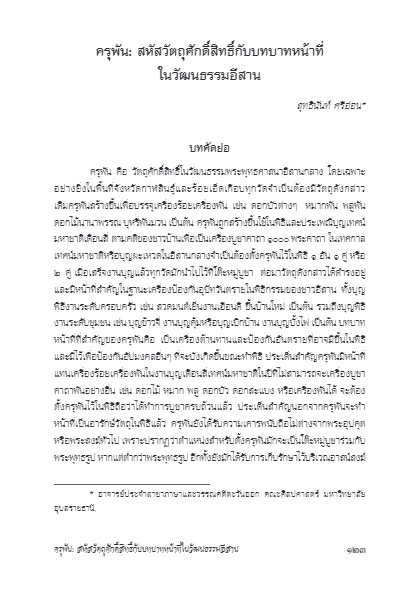สุทธินันท์ ศรีอ่อน
บทคัดย่อ
ครุพัน คือ วัตถุศักดิ์สิทธิ์ในวัฒนธรรมพระพุทธศาสนาอีสานกลาง โดยเฉพาะอย่างยิ่งในพื้นที่จังหวัดกาฬสินธุ์และร้อยเอ็ดเกือบทุกวัดจำเป็นต้องมีวัตถุดังกล่าว เดิมครุพันสร้างขึ้นเพื่อบรรจุเครื่องร้อยเครื่องพัน เช่น ดอกบัวต่างๆ หมากพัน พลูพัน ดอกไม้นานาพรรณ บุหรี่พันมวน เป็นต้น ครุพันถูกสร้างขึ้นใช้ในพิธีและประเพณีบุญเทศน์มหาชาติเดือนสี่ ตามคติของชาวบ้านเพื่อเป็นเครื่องบูชาคาถา 1,000 พระคาถา ในเทศกาลเทศน์มหาชาติหรือบุญผะเหวดในอีสานกลางจำเป็นต้องตั้งครุพันไว้ในพิธี 1 อัน 1 คู่ หรือ 2 คู่ เมื่อเสร็จงานบุญแล้วทุกวัดมักนำไปไว้ที่โต๊ะหมู่บูชา ต่อมาวัตถุดังกล่าวได้ดำรงอยู่และมีหน้าที่สำคัญในฐานะเครื่องป้องกันอุปัทวันตรายในพิธีกรรมของชาวอีสาน ทั้งบุญพิธีงานระดับครอบครัว เช่น สวดมนต์เย็นงานเฮือนดี ขึ้นบ้านใหม่ เป็นต้น รวมถึงบุญพิธีงานระดับชุมชน เช่น บุญข้าวจี่ งานบุญคุ้มหรือบุญเบิกบ้าน งานบุญบั้งไฟ เป็นต้น บทบาทหน้าที่ที่สำคัญของครุพันคือ เป็นเครื่องต้านทานและป้องกันอันตรายที่อาจมีขึ้นในพิธี และมีไว้เพื่อป้องกันอัปมงคลอื่นๆ ที่จะบังเกิดขึ้นขณะทำพิธี ประเด็นสำคัญครุพันมีหน้าที่แทนเครื่องร้อยเครื่องพันในงานบุญเดือนสี่เทศน์มหาชาติในปีที่ไม่สามารถจะเครื่องบูชาคาถาพันอย่างอื่น เช่น ดอกไม้ หมาก พลู ดอกบัว ดอกสะแบง หรือเครื่องพันได้ จะต้องตั้งครุพันไว้ในพิธีถือว่าได้ทำการบูชาครบถ้วนแล้ว ประเด็นสำคัญนอกจากครุพันจะทำหน้าที่เป็นอารักษ์วัตถุในพิธีแล้ว ครุพันยังได้รับความเคารพนับถือไม่ต่างจากพระอุปคุตหรือพระสงฆ์ทั่วไป เพราะปรากฏว่าตำแหน่งสำหรับตั้งครุพันมักจะเป็นโต๊ะหมู่บูชาร่วมกับพระพุทธรูป หากแต่ต่ำกว่าพระพุทธรูป อีกทั้งยังมักได้รับการเก็บรักษาไว้บริเวณอาสน์สงฆ์สำหรับเจ้าอาวาส ดังนั้น ครุพันในวัฒนธรรมอีสานจึงไม่ใช่เพียงวัตถุในพิธีทั่วไป หากแต่เป็นวัตถุศักดิ์สิทธิ์ที่มีบทบาทหน้าที่เช่นเดียวกับพระอุปคุตที่จะต้องได้รับการเชิญมาในพิธี และมีสถานะเช่นเดียวกับพระสงฆ์ที่มีอายุพรรษาเช่นเจ้าอาวาส และมีสถานะเป็นเช่นเดียวกับพระเครื่องหรือของมงคล
คำสำคัญ : วัตถุศักดิ์สิทธิ์; บทบาทหน้าที่; พระอุปคุต
(ตีพิมพ์ใน วารสารไทยศึกษา ปีที่ 13 ฉบับที่ 2 (กรกฎาคม – ธันวาคม 2560) หน้า 123-151)
Garuphan: 1000 Holy Objects and Functions in Isan Culture
Suddhinan Sri-on
Abstract
The Kharuphan are holy objects of the Buddhism culture in central Isan. Almost all temples in Kalasin and Roi-Et provinces have the Kharuphan. In the past, the Kharuphan was created to hold a variety of items, such as various kinds of lotus, rolled betel nuts and leaves, flowers of different kinds and rolled cigarettes used in the Mahachat Sermon of the fourth month. They were used as offerings for 1,000 khatha.
At the Mahachat Sermon Festival or Bunphawet in central Isan, a monk or an elderly man had to place a Kharuphan, one or two pairs of them. When the ceremony ended, all of the temples would place the Kharuphan on their altar table set. Now the Kharuphan have been used as protective charms in Isan rituals, including family rituals, such as the evening prayer and the house warming ceremony, as well as community rituals, such as pan-fried sticky rice ceremony (Bun Khao Ji), Bun Khum or Bun Boek Ban, and the rocket festival (Bun Bang Fai). The Kharuphan is mainly used as protective charms against inauspicious events that might occur during the ceremony. Another role of the Kharuphan is to represent offerings for the Mahachat Sermon, since offerings items are hard to find in some years, such as flowers, betel nuts and leaves, lotus and Sabang flowers.
In addition to the role as a protective charm in rituals, Isan people respect the Kharuphan like Phra Upagutta or monks. This is so because the Kharuphan is placed on an altar table along with Buddha images, although placed below the Buddha image. In addition, the Kharuphan is usually kept at the seat of a temple’s abbot. Hence, the Kharuphan in Isan culture is not only an object for a Buddhist ceremony, it is also a sacred object that has the same role as Phra Upagutta that needs to be enshrined in the ceremonies. It has the same status as a revered monk and as an abbot, as well as the same status as an amulet.
Keywords : Holy objects; role; Phra Upagutta
(Published in Journal of Thai Studies Volume 13 Number 2 (July – December 2017) Page 123-151)
บทความ / Full Text : Download
